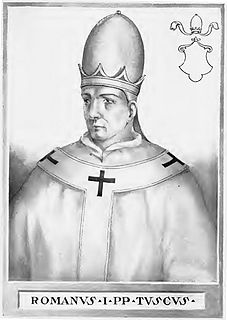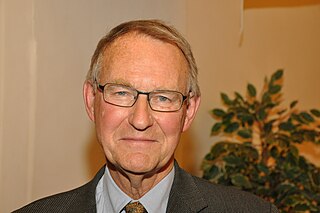
Benedict of Nursia is a Christian saint, who is venerated in the Roman Catholic Church, the Eastern Orthodox Church, the Oriental Orthodox Churches, the Anglican Communion and Old Catholic Churches. He is a patron saint of Europe.

In architecture, a gargoyle is a carved or formed grotesque with a spout designed to convey water from a roof and away from the side of a building, thereby preventing rainwater from running down masonry walls and eroding the mortar between. Architects often used multiple gargoyles on a building to divide the flow of rainwater off the roof to minimize the potential damage from a rainstorm. A trough is cut in the back of the gargoyle and rainwater typically exits through the open mouth. Gargoyles are usually an elongated fantastical animal because the length of the gargoyle determines how far water is directed from the wall. When Gothic flying buttresses were used, aqueducts were sometimes cut into the buttress to divert water over the aisle walls.

Pope Romanus was Pope from August to November 897.

SPQR refers to the government of the ancient Roman Republic. It appears on Roman currency, at the end of documents made public by inscription in stone or metal, and in dedications of monuments and public works.

Pope John XIX was Pope from May 1024 to his death in 1032.
Romanus, hellenized as Romanos (Ῥωμανός) was a Roman cognomen and may refer to:

The Vergilius Romanus, also known as the Roman Vergil, is a 5th-century illustrated manuscript of the works of Virgil. It contains the Aeneid, the Georgics, and some of the Eclogues. It is one of the oldest and most important Vergilian manuscripts. It is 332 by 323 mm with 309 vellum folios. It was written in rustic capitals with 18 lines per page.
Robert Romanus, also billed as Bob Romanus, is an American actor and musician who has starred in film and television. He is perhaps best known for his role in the 1982 comedy Fast Times at Ridgemont High, as Italian-American ticket scalper Mike Damone, and as Natalie Green's boyfriend Snake on The Facts of Life. He also starred in the 1985 film Bad Medicine.
John le Romeyn, died 1296, was a medieval Archbishop of York.

Lars Gabriel Romanus, born 25 January 1939 in Helsingborg, is a Swedish liberal politician. He served as Minister of Social Affairs 1978–1979, as a member of the Riksdag 1969–1982 and again 2002–2006. He has chaired the Swedish delegation to the Nordic Council and was President of the council in 2004. He has also been chairman of Svenska Barnboksinstitutet. Romanus was the CEO of Systembolaget from 1982 to 1999. He has worked for restrictive politics on alcohol for a long time.

Saint Romanus of Caesarea is venerated as a martyr. In 303 or 304, at the beginning of the Diocletian persecution, a deacon called Romanus of Caesarea in Palestine suffered martyrdom at Antioch. He was taken prisoner, was condemned to death by fire, and was bound to the stake; however, as Emperor Galerius was then in Antioch, Romanus was brought before him. At the emperor's command Romanus' tongue was cut out. Tortured in various ways in prison he was finally strangled.
Romanus was the second bishop of Rochester and presumably was a member of the Gregorian mission sent to Kent to Christianize the Anglo-Saxons from their native Anglo-Saxon paganism. Romanus was consecrated bishop around 624 and died before 627 by drowning. Little is known of his life beyond these facts.
Richard Romanus is an American actor. Among other roles, he has appeared in Martin Scorsese's Mean Streets and provided voices for Ralph Bakshi's animated films Wizards and Hey Good Lookin'. He played Richard La Penna, Jennifer Melfi's ex-husband, later husband again, in four episodes of The Sopranos from 1999 to 2002. In 1999, he co-wrote the Christmas film If You Believe along with his wife Anthea Sylbert, which was nominated for a Best Original Screenplay award by the Writers Guild of America.

The Mahabharata is a 1989 film version of the Hindu epic Mahabharata directed by Peter Brook. Brook's original 1985 stage play was 9 hours long, and toured around the world for four years. In 1989, it was reduced to under 6 hours for television. Later it was also reduced to about 3 hours for theatrical and DVD release. The screenplay was the result of eight years' work by Peter Brook, Jean-Claude Carrière and Marie-Hélène Estienne.
Romanus of Samosata was a martyr for Christianity in Syria in 297. He and his companions, Jacob, Philotheus, Hyperechius, Abibus, Julianus, and Paregorius were all subject to a variety of tortures before being hanged to trees and then nailed against them. They are mentioned in the Menaea Graeca and the Menologium der Orthodox-Katholischen Kirche des Morgenlandes. Their feast day is January 29.
Saint Romanus Ostiarius is a legendary saint of the Catholic Church. His legend states that he was a soldier who converted to Christianity by the example of Saint Lawrence, who baptized Romanus after the soldier was imprisoned. He became a church ostiary in Rome and was later martyred.
Saint Romanus of Condat is a saint of the fifth century. At the age of thirty five he decided to live as a hermit in the area of Condat. His younger brother Lupicinus followed him there. They became leaders of a community of monks that included Saint Eugendus.
The Frankish emperor Charlemagne took an intense interest in church music, and its propagation and adequate performance throughout his empire. He not only caused liturgical music to flourish in his own time, throughout his empire in Western Europe, but he laid the foundations for the subsequent musical culture of the region. The emperor's agents and representatives were everywhere ordered to watch over the faithful carrying out of his orders regarding music.
The Hull triple trawler tragedy was the sinking of three trawlers from the British fishing port of Kingston upon Hull during January and February 1968. A total of 58 crew members died, with just one survivor. The three sinkings brought widespread national publicity to the conditions in which fishermen worked, and triggered an official inquiry which led to major changes to employment and working practices within the British fishing industry.
Theodosius Romanus was the Patriarch of Antioch, and head of the Syriac Orthodox Church from 887 until his death in 896.












